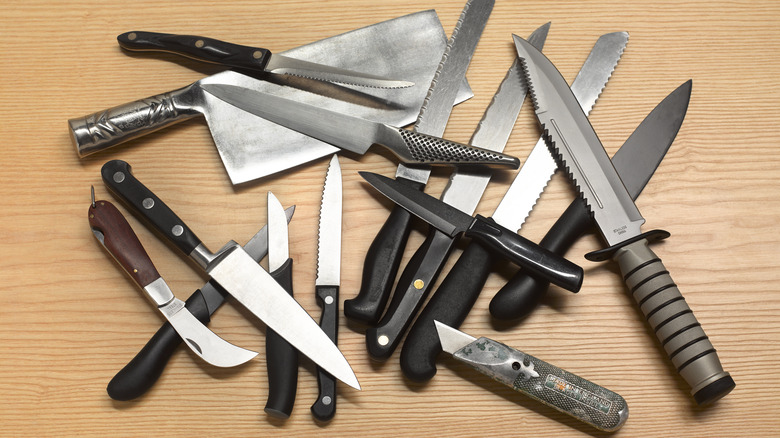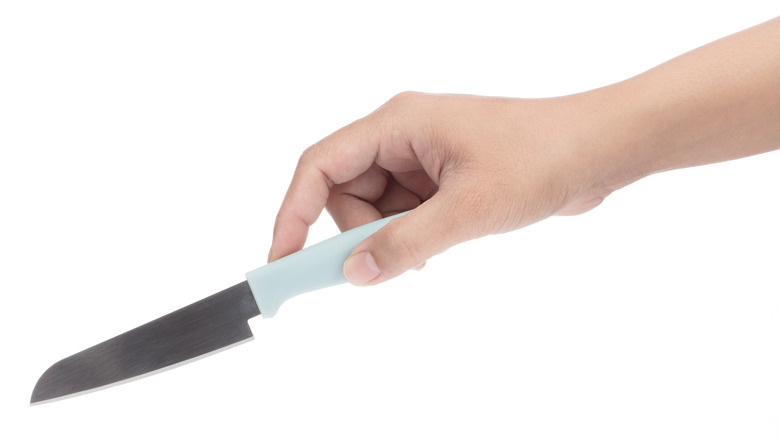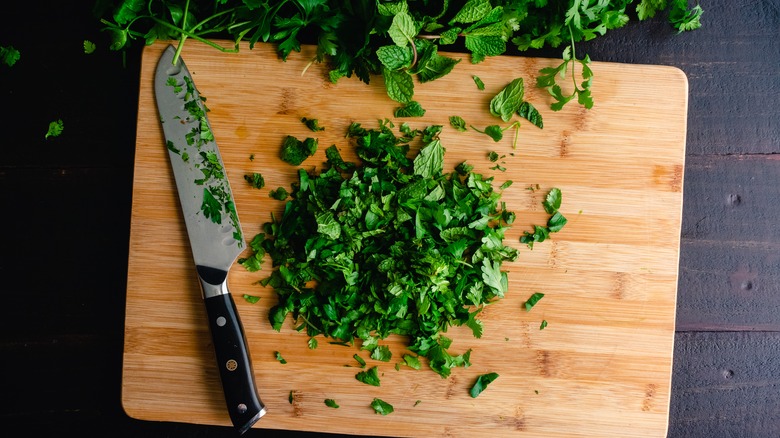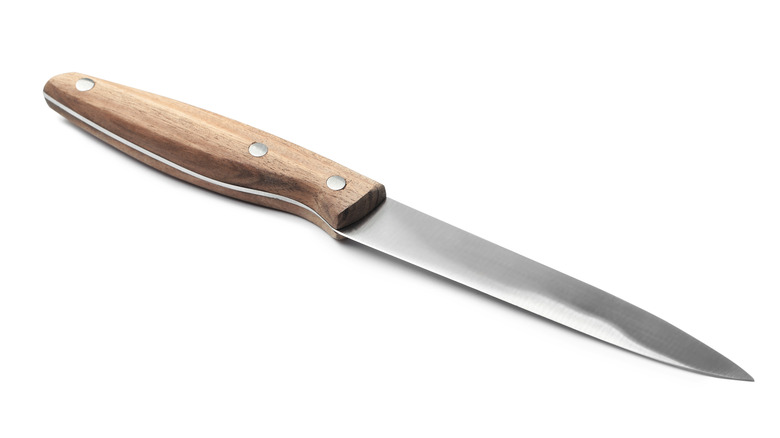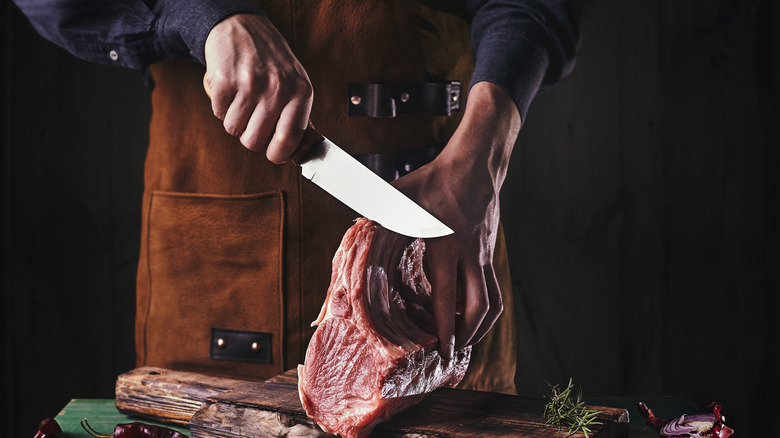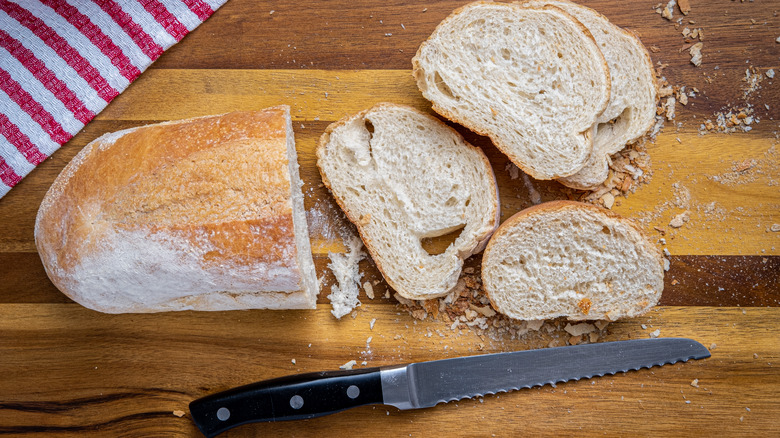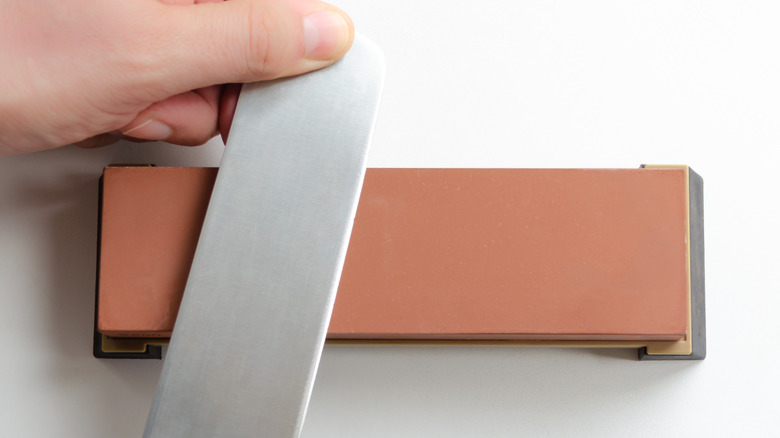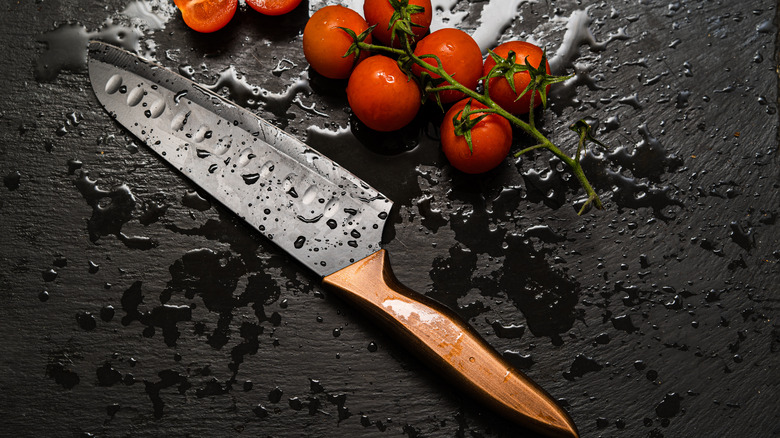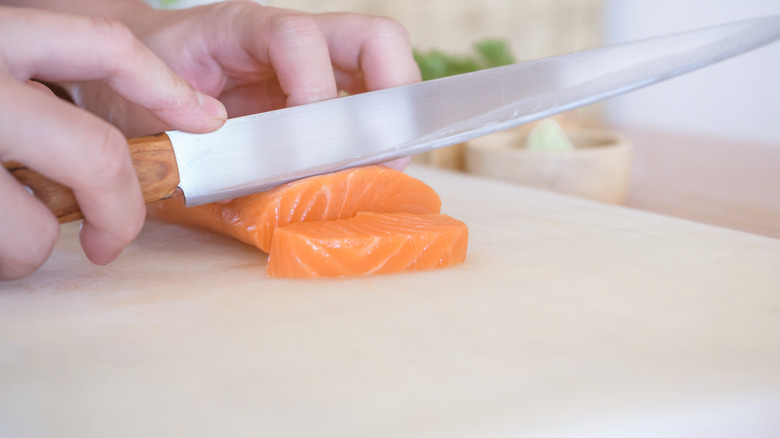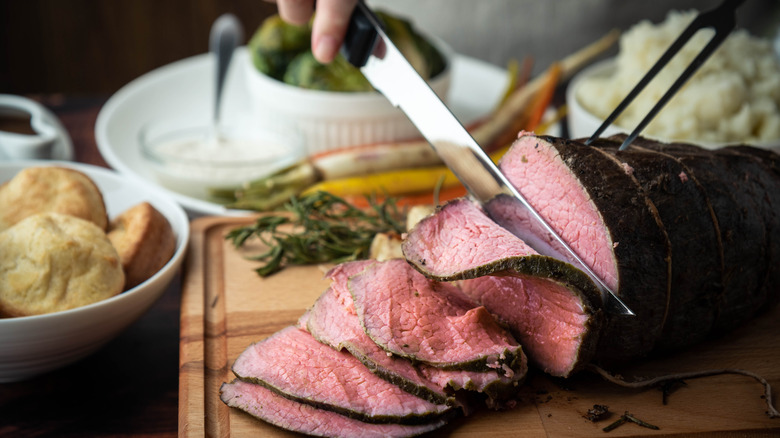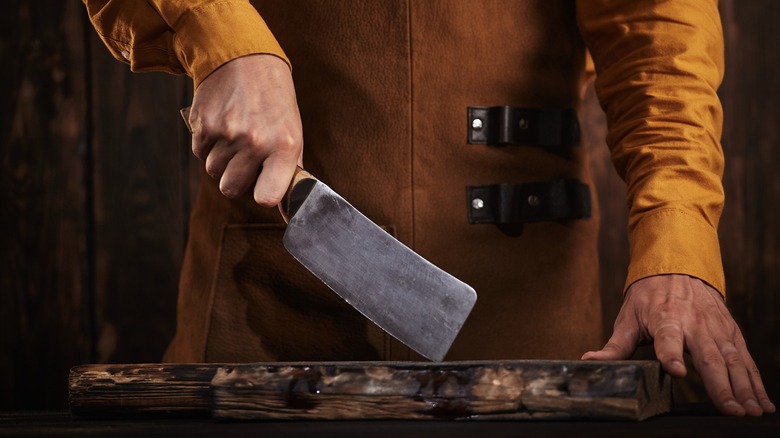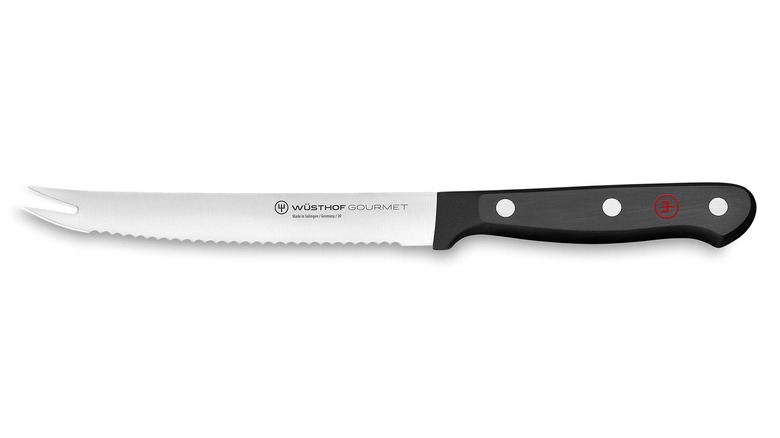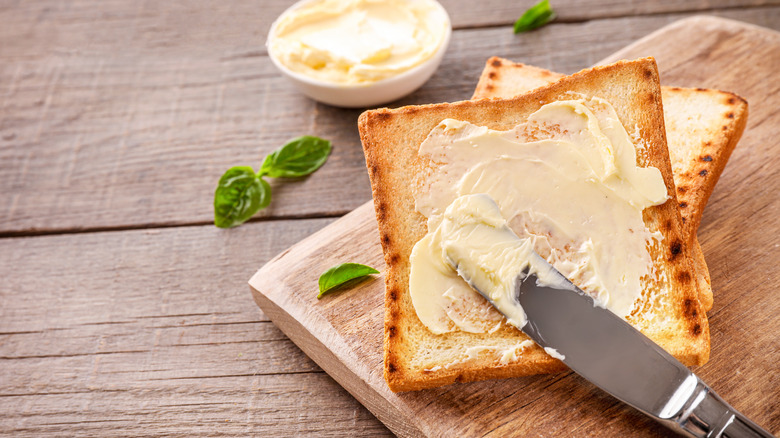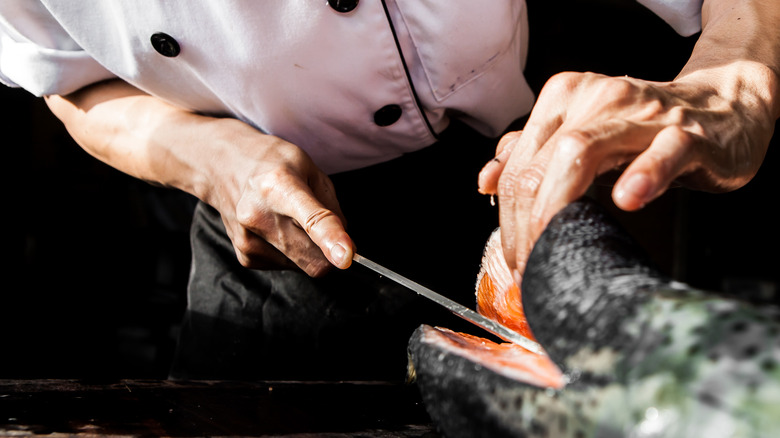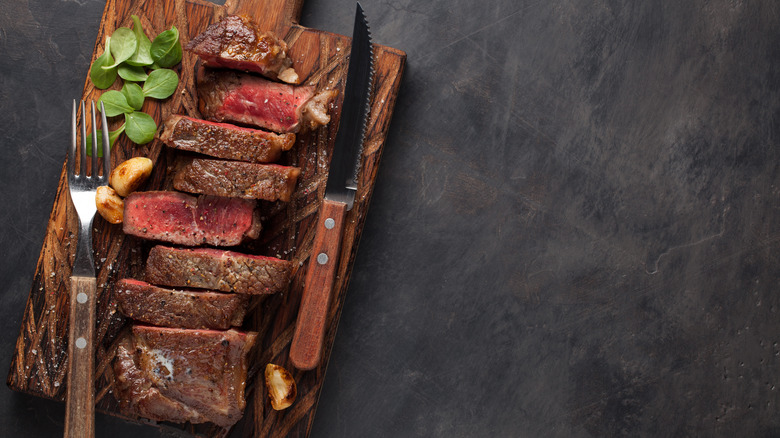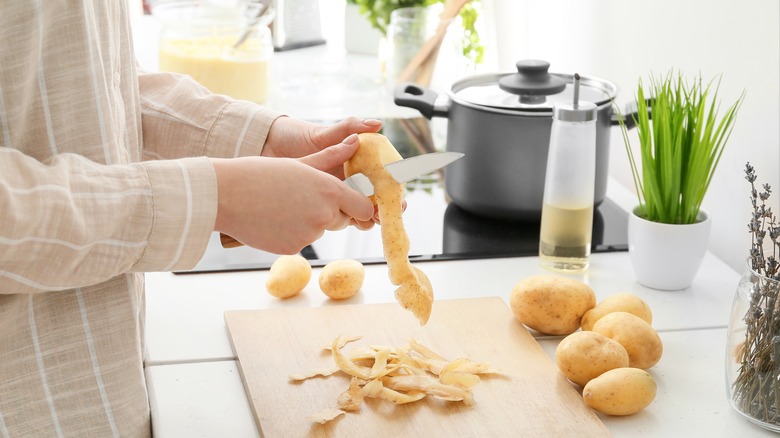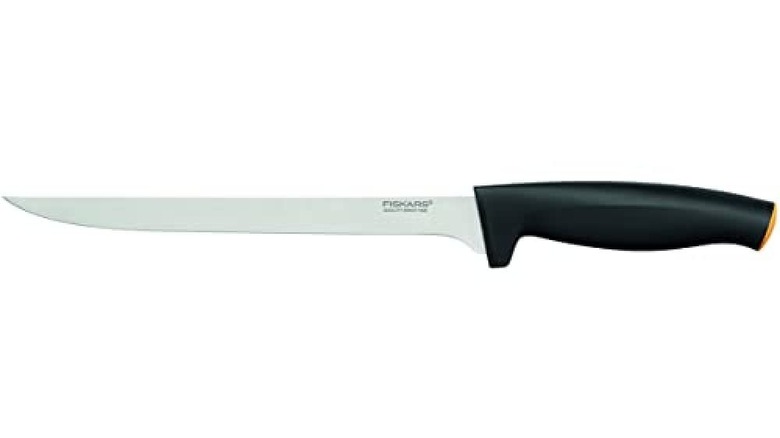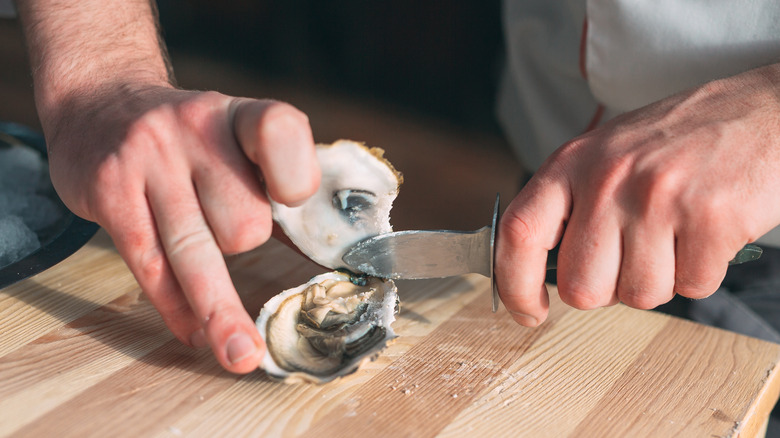30 Types Of Knives, Explained
We may receive a commission on purchases made from links.
Knives are a must-have item for any home chef. Whether you're slicing onions for a homemade sauce or cutting through a crusty ciabatta for Sunday dinner, you'll need to turn to a knife for a helping hand. But, with the sheer number on the market, how do you decide which style of knife to use? And if you're stocking your first home kitchen, how do you decide which knives are most essential?
When looking to purchase cutlery, you should consider a few important factors. First, what do you plan to do with the knife? If you are a vegan, purchasing a carving knife or an oyster knife just isn't practical. If you only have a budget for a few knives, you should consider which types will offer the most utility.
Equally as important as purchasing a knife is purchasing a sharpening set to ensure your blades are ready to go whenever you need them. Here is our comprehensive guide to the different styles of knives on the market.
Paring knife
A paring knife embodies the phrase "small but mighty." It is a knife most practical for trimming fondant from a cake or removing pepper membranes. Unlike a utility of a chef's knife, the paring knife has a much smaller blade that can easily maneuver in small spaces. Your ideal paring knife should be about 3 inches in total to maintain its maneuverability.
Paring knives come in several blade shapes. A sheep's head, for example, is a straight blade ideal for chopping garlic or cherry tomatoes. Unlike other types of knives, you won't have to rock the knife on the cutting board. Don't use this small blade for cutting through meat — instead limit use to small veggies, spices, and shrimp peels. When you hold a paring knife, you should try to grip the handle with three or four fingers and your thumb to rhythmically chop through small morsels. Above all, keep your paring blade sharp, so it's ready for whenever you need it.
Chef's knife
The second most important knife to have in your kitchen besides a paring knife is a chef's knife. We polled home cooks and found 40% of those surveyed consider a chef's knife the most important in the kitchen compared to other types — and for good reason. This multipurpose knife measures between 8 and 10 inches and offers a seamless mincing, dicing, and chopping experience for vegetables, herbs, and everything in between.
Unlike other knives, the chef's knife has a double-bevel blade and a sharp tip. According to Made-In Cookware, a chef's knife utilize a rocking motion to slice through food with ease. Made-In notes that the chef's knife is one of the most utilitarian knives because it can be used for julienning carrots, spatchcocking chicken, or cutting onions. The one exception for when a chef's knife may not be the most optimal kind of knife to use is when slicing watery vegetables like cucumbers, according to the cookware manufacturer. Knives such as a Santoku knife, with a fluted blade, cause the wet vegetables to slide off easier from the blade, which can in turn slice down prep time.
Utility knife
Chef Alton Brown recommends having a utility knife in your kitchen arsenal. At less than 6 inches, a utility knife is the go-between option if you don't have a paring knife or a chef's knife. It's perfect for slicing fruit for a fruit salad or preparing soft veggies for a stew. You can also purchase a utility knife with a serrated blade for slicing through crusty bread — this type of serrated knife has the name of a "sandwich knife."
According to Bustle, utility knife blades can come in many different materials including stainless steel, carbon steel, and ceramic. For folks seeking a long-lasting knife with minimal risk of chipping or upkeep including sharpening, we recommend purchasing a classic stainless steel knife or a lightweight version made out of ceramic material. You'll find that handles come in plastic, thermoplastic, or wood handles, depending on user preference and price point.
Boning knife
A boning knife is essential for carnivores to have. These thin knives are razor-sharp and used to cut apart pieces of fish and meat with bones. Since so much meat is sold at the grocery store boneless, most home cooks won't need to worry about having one of these knives in a kitchen block.
Per Field and Stream, boning knives are essential for folks who hunt or fish regularly and want to debone meat with ease. The blade on a boning knife is flexible for working around bones, cartilage, and connective tissue like tendons and ligaments, explains the site. You can purchase boning knifes made out of hard metals or soft metals. Hard metals are more durable, long-lasting, and expensive, but you will constantly have to sharpen these knifes to maintain optimal performance, per Field and Stream, while soft metals are generally less expensive, more flexible, and easier to sharpen than hard metals. But, you might have to sacrifice durability on those knife materials. The sheer abuse a boning knife can take in a kitchen makes many users more keen to soft metals, and Field and Stream finds these types are easier to hone and get back into work with.
Serrated knife
Serrated knifes can come into many uses in the kitchen, but one of the most popular ways to use this knife is to cut bread. The teeth on a serrated knife make cutting and slicing easier than a sharp chef's knife or a cleaver. These unique knives can come in a variety of shapes and sizes, from the size of a measly utility knife to the impressive 10-inch chef's knife.
While serrated knifes require infrequent sharpening compared to other kitchen knives, you will have to take some precautions to ensure the quality of the blade. You'll have to sharpen each tooth with a honing rod to ensure that each burr is sharp enough to slice through ciabatta without turning it into crumbs. Then, you'll want to remove the tiny metal fragments (known as burrs) from the knife before returning it into circulation. Remove the burrs with sandpaper or using the side of your whetstone.
Nakiri knife
Per Made-In Cookware, a Nakiri knife is a Japanese style knife with a thick blade. This knife resembles a cleaver but with a few distinct differences: It has a thin, symmetrical blade perfect for chopping. Unlike a chef's blade that uses a rocking motion, the shape of the Nakiri is ideal for up-and-down chopping, explains Made-In Cookware. The Nakiri blade is also distinct because it will sit flat on the cutting board.
At about 6 inches in length, this knife is useful for maintaining control over the blade and maneuvering through small cavities, finds Made-In Cookware. However, the square edge of this knife limits how it can be used for deep cuts in the kitchen. The Nakiri is perfect for chopping herbs, garlic, or onions. You should opt for another knife instead of a Nakikri for chopping meat and dense vegetables like carrots, says Made-In, because the blade of the Nakiri is much too thin to sustain heavy damage.
Santoku knife
A Santoku is another Japanese knife used in the kitchen. Per Kamikoko, the Santoku, like the chef's knife, can be used for everything from cutting vegetables to slicing fruit and come in a variety of materials for both home and professional use, such as ceramic and stainless steel. The Santoku knife has a much thinner blade than a chef's knife and is lighter in weight. Santoku knives can include an either single-sided or a dual bevel. Some types of Santoku blades come with Granton edges, which can make food much easily to slide off the blade. This is why a Santoku is preferable to a chef's knife for slicing wet vegetables and foods, says Kamikoko.
Santoku knives typically vary in size but range from 6 inches to 7 inches. The word "santoku" refers to the "three uses" of the knife in Japanese: chopping, dicing, and mincing. You can use the Santoku to slice cheese, chop meat, or scoop food off a cutting board with its wide blade.
Yanagiba knife
The Yanagiba knife is especially useful for cutting thin fish and sushi. In Japanese, the name translates to "willow-leaf blade," which reflects its shape and daintiness. The Yanagiba knife has a single blade concave to one side, and the angle makes cutting fresh fish especially easy because there is less contact between the flesh and the bones. This preserves the soft texture of the fish and provides an easy release once the fish has been sliced.
Yanagiba knives are best suited for slicing boneless filets of raw fish, filleting small and medium sized fish, and skinning a variety of fish for sushi. The thinness and shape of the blade does not make this specialty blade conducive to other kitchen applications, so you are best keeping a chef's knife or a paring knife handy for cutting through meat or vegetables. If you are a sushi or sashimi enthusiast, though, you are best off purchasing a Yanagiba knife for your home kitchen.
Carving knife
A carving knife is important to have for Thanksgiving, but how useful is this type of knife otherwise? Per Culinary Lore, the ideal purpose of a carving knife is to cut uniform pieces of poultry and meat. The carving knife is more narrow than a chef's knife and can range in size up to 14 inches, and the culinary site explains that the larger the carving knife, the easier the slicing will be and the less damage to the meat. Most modern carving knives contain Granton edges to help the meat slide seamlessly off the blade. You might find carving knives with rounded tips in some professional applications (such at buffet carving stations), says Culinary Lore.
One item that has surged in popularity is the electric carving knife. When the applianced it powered on, the two blades simultaneously cut through meat with ease. But, the practicality of this type of knife is minimal because of the difficulty to clean it, as well as the infrequent use for this appliance in most households.
Butcher knife
The cleaver is a scary knife to look at, but it is important to have in a carnivore's kitchen. This knife, which is also known as a butcher knife, is a rectangular blade with a front-heavy weight in the blade of the knife rather than the handle. The New York Times says the cleavers are separated into two separate categories: meat cleavers (guado) and vegetable cleavers (caidao). The meat cleaver has a thicker blade for hacking through meat while the vegetable cleaver is a little more dainty, says the news site. The chopping cleaver is a hybrid between these two types with a thick heel and thin front — making it an especially useful tool in the kitchen.
You can use a cleaver for many uses outside of slicing. One creative way to use your cleaver is to scrape ingredients across a cutting board with its wide berth. You can also pound a chicken breast with the butt of a cleaver, descale the fish using the bolster (armpit) of the cleaver. Choke up on the cleaver to peel apples for an apple pie — just don't use the cleaver for round foods because you'll find these pesky foods difficult to cut without losing a finger.
Tomato knife
A tomato knife is a small, serrated knife most commonly used for slicing tomatoes. These serrated blades are easily identified for the two points on the tip of the blade used to lift and move the tomato slices after the pieces have been cut. According to Kitchen Crews, the two tips on the blade can also help easily remove the core of the fruit, so you can pick the peel of the tomato with the tip of the knife without destroying the flesh of the fruit. The Crowded Table further notes that a tomato knife needs serrated edges to slice through tomatoes with ease.
You may also hear the tomato knife referred to as a fork-tipped utility knife. The tip on this knife is perfect for cutting through citrus fruits or spearing cocktail garnishes as well. Delighted Cooking notes that the tomato knives are made with stainless steel — a material that is comparatively easy to sharpen.
Butter knife
No proper place setting would be complete without a butter knife. Once you have a good butter knife set for your kitchen, you won't need to purchase another for the foreseeable future. Unless you have a butter dish with a soft bowl of butter, slicing through the butter would be impractical with a standard kitchenware knife (via the Charlotte Observer). The shape of the butter knife is perfectly for evenly spreading peanut butter, hazelnut spread, or cream cheese on your favorite crackers, too. Butterknives are also safer for cutting through soft things than standard knives.
Most butterknives are made from stainless steel, but some handles can be coated in a thin plastic layer for better gripping. If you're looking for a cheap butter-knife for your home kitchen, your go-to should be the Amazon stainless steel butter knife with rounded edges. A dozen of these knives costs a mere $15.22.
Salmon knife
A salmon knife is a unique type of carving knife used for carving salmonoids like trout and salmon. According to Soho Knives, salmon slicing knives are usually more than 10 inches long; this allows the preparer to be able to reach around and filet the salmon with ease. The blade for this life is long, thin, and rounded at the end to prevent damaging the salmon.
You can purchase a salmon knife with clefts to slice through salmon with ease and prevent any parts of the fish from sticking to the blade. Although this type of knife is almost used explicitly for cutting through salmon, you can use a salmon knife in place of a ham slicer, per Knives and Tools. Most salmon knives are made of steel for longevity and longterm durability. We recommend hand-washing these knives to prevent warping or damage to the blade from a dishwasher.
Steak knife
Everyone needs a good set of steak knives for the summer grilling season. These small knives have a serrated blade with a sharp tip for simple slicing thick steaks, pork chops, and even potatoes. The standard steak knife either has a wooden or a plastic handle for easy maneuvering and comfortable cutting.
You can purchase a variety of shapes and sizes of steak knives depending on the feel you want. If you don't want to hone and sharpen each individual tooth on a steak knife, you can purchase a non-serrated steak knife for easy cutting. If you want a durable knife, you might also consider purchasing a knife with a resin to better maintain the steel and longevity of the steak knife. The average steak knife can range in price from the Chicago Cutlery four-piece walnut set around $30 to the Wusthof Classic four-piece set at over $300.
Peeling knife
Peeling knives are the perfect thing you need in the kitchen for when your vegetable peeler grows legs and walks away. According to Knives Academy, a peeling knife ranges in size from 3 to 5 inches and is commonly called a "bird's beak knife" because of the concave shape of the blade faces toward the inside rather than the outside. This blade is also rigid so it can easily cut through peels. The shape of the blade makes peeling circular fruits, like apples, much easier than if the blade was straight.
To protect your hands, the peeling knife is typically more dense and ergonomic; this ensures the blade won't slip and puncture your hand, says Knives Academy. If you're looking for a comfy handle, you should consider purchasing a DALSTRONG 2.75" Peeling Knife made of high-quality German Steel. At only $35, at time of publication, you can expect to have this knife for a very long time.
Fillet knife
A fillet knife is a more flexible type of boning knife able to slice along the spine of the fish and move toward its skin with ease. These knives are also relatively small for easy maneuvering in the body cavity of a halibut or a snapper, and according to Dalstrong, when shopping for a the perfect filleting knife, you'll want to look for a knife with a corrosion-resistant material, since most fish come from saltwater environments. The fillet knife should have an angled blade between 12 and 17 degrees for the perfect sharpness and cutting through flesh, says Dalstrong.
The exact length of blade you plan to purchase will depend on what types of fish you plan on working with the most. Perch, trout, and walleye require a small blade at around 6 inches, finds Dalstrong. In comparison, tuna and halibut need a blade at least 8 inches in length to cut through the flesh without going missing. Moreover, you can choose to purchase a wood, plastic, or rubber handle based on ergonomics and your desired texture.
Oyster knife
As the name implies, an oyster knife is used for shucking oysters. Per the Shellfish Broker, oysters have significantly shorter blades than other sharp kitchen knives, along with a more comfortable handle that takes the pressure off your hands when shucking. Most oyster knives are made from stainless steel or carbon steel, all materials resistant to corrosion.
The exact oyster knife shape is dependent on how experienced the handler is. New Haven oyster knives, for example, have a short, wide blade with a pointed tip. Shellfish Broker explains the New Haven is best for folks just learning to shuck oysters because the knife is less pointy, while the Providence blade has a pointier tip and is commonly used for shellfish pros. The Kaki Muki is a Japanese oyster knife used for Pacific and Kumamoto oysters, and it has a longer wooden handle and blade to crack these oysters from the side. If you want a dual purpose knife that you can use to open clams, consider a Seki knife.
